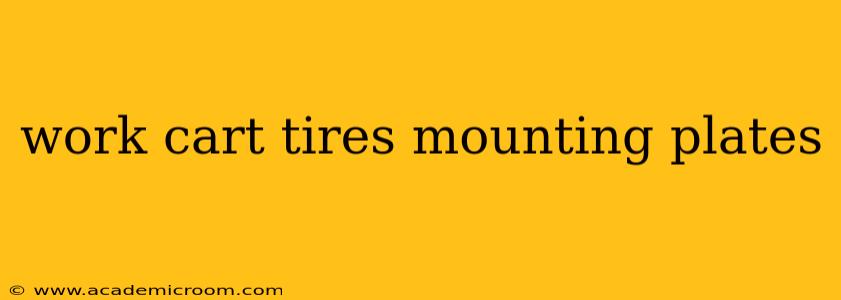Work carts, essential for various industries and tasks, rely heavily on their tires for maneuverability and durability. A critical component often overlooked is the tire mounting plate—the sturdy metal piece that securely attaches the wheel to the cart's frame. Understanding the nuances of work cart tire mounting plates is key to maintaining a safe and efficient workspace. This guide dives deep into the specifics of these plates, addressing common questions and offering valuable insights.
What are Work Cart Tire Mounting Plates?
Work cart tire mounting plates are robust metal plates, typically made of steel or other durable materials, designed to securely fasten the wheel assembly to the cart's frame. They act as the crucial intermediary, ensuring the tire remains firmly attached, preventing slippage and maintaining the cart's stability during operation. The design often incorporates various features like pre-drilled holes for easy bolting, slots for adjustments, and potentially even integrated bearings for smoother rotation. The specific design varies based on the cart's size, weight capacity, and intended application.
What Types of Mounting Plates Exist for Work Carts?
Several types of mounting plates cater to different work cart designs and needs. Some common variations include:
-
Fixed Mounting Plates: These plates offer a rigid, non-adjustable connection. They are ideal for carts with fixed wheel positions and are generally simpler and less expensive.
-
Adjustable Mounting Plates: These plates allow for minor adjustments to wheel alignment or position, accommodating slight variations in the cart's frame or tire size. This flexibility proves invaluable when working with diverse terrains or needing to fine-tune the cart's handling.
-
Swivel Mounting Plates: This type of plate allows the wheel to rotate freely, providing enhanced maneuverability. This is frequently found on carts that need to navigate tight spaces or frequently change direction. They often incorporate bearings for a smooth, low-friction swivel action.
How Do I Choose the Right Mounting Plate for My Work Cart?
Selecting the appropriate mounting plate depends on several factors:
-
Cart Weight Capacity: Heavier carts require more robust plates capable of handling the increased load and stress.
-
Tire Size: The plate must be sized appropriately to accommodate the wheel diameter and width. Mismatched sizes can lead to instability and potential failure.
-
Terrain: The type of terrain the cart operates on influences the choice. Rougher terrain may benefit from fixed plates for enhanced stability, while smoother surfaces may allow for more maneuverable swivel plates.
-
Maneuverability Requirements: If frequent changes in direction are needed, swivel plates are highly beneficial.
-
Material Durability: Choose a plate made of a material that can withstand the expected wear and tear of the intended use. Steel is a popular choice for its strength and durability.
What are Some Common Problems with Work Cart Tire Mounting Plates?
Several issues can arise with work cart tire mounting plates:
-
Corrosion: Exposure to moisture can cause corrosion, weakening the plate's structural integrity. Regular inspection and proper maintenance are essential.
-
Loose Bolts: Over time, bolts can loosen due to vibration or stress, compromising the secure attachment of the tire. Regular tightening is recommended.
-
Plate Deformation: Excessive loads or impacts can deform or damage the plate, requiring replacement.
-
Bearing Wear (Swivel Plates): On swivel plates, bearing wear can lead to increased friction and reduced maneuverability. Regular lubrication and inspection are important.
How Often Should I Inspect My Work Cart Tire Mounting Plates?
Regular inspection is crucial for safety and to prevent unexpected failures. It's recommended to inspect the mounting plates at least monthly, or more frequently depending on the intensity of use and the environment. Check for signs of corrosion, loose bolts, deformation, or bearing wear.
Can I Repair a Damaged Mounting Plate?
Minor damage, such as minor scratches or superficial corrosion, might be manageable with appropriate repair methods. However, significant deformation or cracks necessitate replacement. Attempting to repair severely damaged plates can compromise safety and is generally not recommended.
By understanding the critical role of work cart tire mounting plates, conducting regular inspections, and selecting the right type for your specific application, you can ensure optimal safety, efficiency, and longevity for your work cart.
